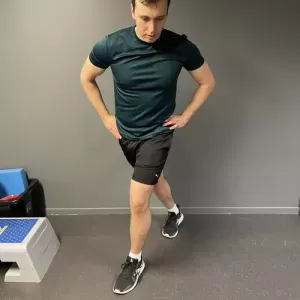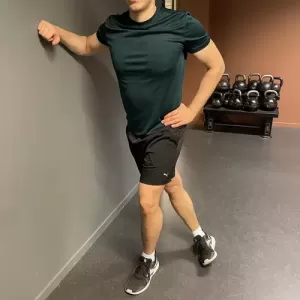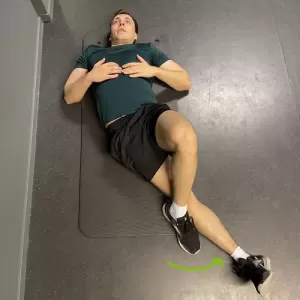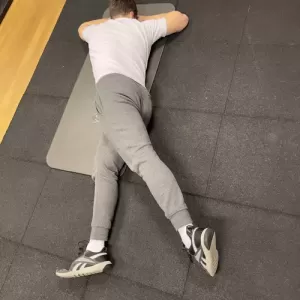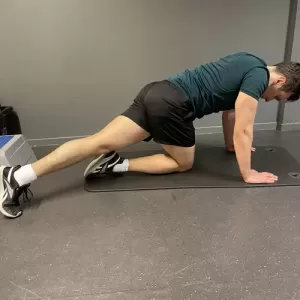The Tensor Fasciae Latae Stretch: How to Improve Hip Flexibility and Reduce Injury Risk
Introduction
The Tensor Fasciae Latae (TFL) is a small yet powerful muscle located on the side of the thigh, connecting the pelvis to the thigh bone. It plays a vital role in hip stability and movement, making it crucial to stretch and strengthen for overall fitness and injury prevention.
In this post, I will explore the Tensor Fasciae Latae Stretch and provide you with the most effective stretches for TFL.
Tensor Fasciae Latae Stretch (TFL) – Best Stretches for Flexibility
Standing TFL Stretch
From a standing position, move one foot behind your body, placing your foot into the following position:
- extension
- adduction
- slightly external hip rotation
Then, hold your pelvis (SIAS) and rotate your pelvis into a posterior pelvic tilt.
Lean gently forward with your upper body and hold for 30s when you feel the tensor fasciae latae stretch.
Wall TFL Stretch
Assume a standing position parallel to a wall and place your forearm against it. Cross one foot over the other and push with your hip toward the wall, keeping your stationary foot firmly planted on the ground. Hold for 30s.
Supine Tensor Fasciae Latae Stretch
Start by laying on your back and crossing your legs. Push your leg with your foot into hip adduction and rotate your hip externally.
Hold this position for 30s.
Prone TFL Stretch
Lay down on your stomach. Rotate one leg to opposite side and try to touch the floor with your toes.
Hold this position for 30s.
Knees-Hands Tensor Fascia Latae Stretch
Place your knees and hands on the ground. Then, move one of your legs into the following position:
- Hip adduction
- Hip external rotation
Make sure your pelvis isn’t rotated forward (anterior pelvic tilt).
Hold for 30s.
Tensor Fasciae Latae Function
- TFL works together with the gluteus maximus and the gluteus medius in hip abduction, which is the movement of lifting the leg out to the side.
- TFL also helps in hip flexion, which is the movement of bringing the knee towards the chest.
- It also works in internal rotation of the hip, where it helps to rotate the thigh inward.
- These movements are performed in daily activities such as walking, running, climbing stairs, and cycling.
- TFL muscle also plays a role in maintaining proper posture and balance by counteracting the pull of the hip adductors and preventing the pelvis from tilting forward.
- TFL tightness can also lead to issues such as IT band syndrome, external snapping hip syndrome and patellofemoral pain syndrome.
Benefits of Tensor Fasciae Latae Stretch
- Improving hip flexibility: The Tensor Fasciae Latae stretch targets the TFL muscle, which can become tight due to overuse or inactivity. Stretching the TFL muscle can help to increase its flexibility and improve overall hip flexibility.
- Reducing the risk of injury: Tightness in the TFL muscle can lead to a number of injuries, such as IT band syndrome and patellofemoral pain syndrome. Stretching the TFL muscle can help to prevent these injuries by keeping the muscle flexible and balanced.
- Improving posture: TFL muscle weakness can cause an anterior pelvic tilt which can lead to back pain, knee pain, and hip pain. Stretching the TFL muscle can help to improve posture by counteracting the pull of the hip adductors and preventing the pelvis from tilting forward.
- Enhancing athletic performance: The TFL muscle is important for athletes who are involved in sports that require a lot of running, jumping or kicking, such as soccer or basketball. Stretching the TFL muscle can help to improve hip stability and movement, which can enhance athletic performance.
- Relieving muscle tension: The Tensor Fasciae Latae stretch can also be used to relieve muscle tension in the TFL muscle and the hip and knee area, which can help to reduce pain and discomfort.
Incorporating the Tensor Fasciae Latae Stretch into Your Fitness Routine
Incorporating the Tensor Fasciae Latae stretch into your regular stretching routine is a great way to ensure that you are keeping your TFL muscle flexible and balanced.
In addition to stretching, it is also important to strengthen the TFL muscle through exercises such as hip abduction and glute bridges.
This will help to maintain muscle balance in hip and knee muscles and prevent injury.
Consider the activities you perform regularly and make sure to stretch and strengthen the TFL muscle accordingly.
For example, runners may benefit from more hip abduction exercises, while weightlifters may benefit from more glute bridges.
Remember that everyone’s body is different and you may need to adjust the intensity of your stretching and strengthening exercises.
Listen to your body and make adjustments as needed.
Consistency is key when it comes to stretching and strengthening exercises. Make sure to include these exercises in your regular fitness routine to see the best results.
Also incorporating foam rolling on TFL and IT band to release muscle tension and improve flexibility can also be beneficial.
Incorporating the Tensor Fasciae Latae stretch into your regular fitness routine, along with other exercises that target the TFL muscle, can help to improve hip flexibility, reduce the risk of injury, and enhance overall fitness. Whether you’re a runner, cyclist, or weightlifter, incorporating the TFL stretch into your exercise program can help you achieve your fitness goals.
Conclusion
The Tensor Fasciae Latae (TFL) muscle plays a vital role in hip stability and movement, making it crucial to stretch and strengthen for overall fitness and injury prevention. The Tensor Fasciae Latae stretch is an effective way to target the TFL muscle and improve hip flexibility. It can also help to reduce the risk of injury, improve posture, and enhance athletic performance. It’s important to perform the stretch gently and without pain, and to incorporate stretching and strengthening exercises into your regular fitness routine to reduce the risk of injury and enhance overall fitness.
Remember to listen to your body and make adjustments as needed, and be consistent with your stretching and strengthening exercises to see the best results.
Want to learn more about stretching?
Continue reading my articles about stretching books and helpful tools for stretching training.

